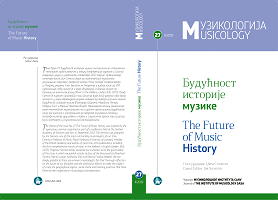О сакралном значењу музичког инструмента и улози пророка Давида у сцени Смрт праведника. Прилог проучавању ликовних представа музичких инструмената у источнохришћанској црквеној уметности
On the Sacral Meaning of the Musical Instrument and the Role of Prophet David in the Scene of the Death of the Rigtheous Man. A Contribution to the Study of the Visual Representations of Musical Instrumentsin the East-Christian Sacral Art
Author(s): Anđela GavrilovićSubject(s): Cultural history, Music, Eastern Orthodoxy, History of Art
Published by: Muzikološki institut SANU
Keywords: King and Prophet David; Death of the Righteous man; musical instruments; organographic analysis; Eastern Christian sacred art; meaning;
Summary/Abstract: The Old Testament prophet David was known in sacred history as the King of Jews, as a prophet, the compiler of the Psalter, but also as a musician. Therefore, he is usually depicted with certain musical instruments in his hands in Eastern Christian art that illustrates sacred history or the biblical narrative. Although the representations of musical instruments in the art of the lands under the Byzantine cultural and spiritual inf uence have been minutely analysed, the existing art still provides opportunities for further research. Until present day most atention was given to the organographic analysis of the musical instruments (M. Velimirović, D. Dević, R. Pejović), while their meaning and the role in the scenes have remained insuf ciently addressed. T e scene analysed in this paper allows for both types of analysis. What is interesting from the iconographic and organographic point of view is the fact that the musical instruments with which Emperor David is portrayed in the scenes of the Death of the Righteous man are different. On this occasion, we will look at scenes of the Death of the Righteous man in the time span from the thirteenth to the seventeenth centuries in Byzantine art, as well as Serbian, Russian and Romanian ecclesiastical art after 1453 from the aspect of iconography. Special attention will be paid to the justif cation of the reasons for the appearance of certain instruments in the hands of King David, as well as their meanings.
Journal: Muzikologija
- Issue Year: 2/2019
- Issue No: 27
- Page Range: 277-302
- Page Count: 26
- Language: Serbian

